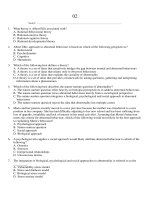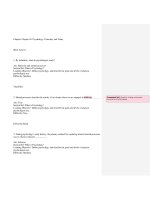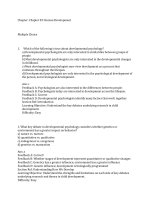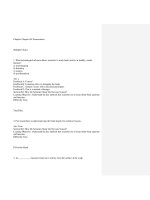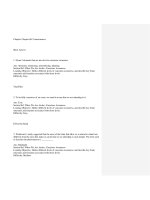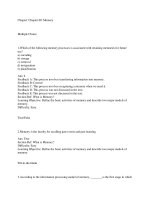TestBank psychology around us 2nd edition comer ch07
Bạn đang xem bản rút gọn của tài liệu. Xem và tải ngay bản đầy đủ của tài liệu tại đây (648.96 KB, 97 trang )
Chapter: Chapter 07: Learning
Multiple Choice
1. Which of the following can be classified as learning?
a) Development of neural connections in the brain
b) Using crutches while your broken leg heals
c) Writing with your left hand while the right hand is injured
d) Acquisition of reading skills
Ans: d
Feedback A: Occurs regardless of learning
Feedback B: Temporary condition
Feedback C: Temporary condition
Feedback D: Correct!
Section Ref: What is Learning?
Learning Objective: Define learning, and distinguish between associative and non-associative
learning.
Difficulty: Easy
True/False
2. Behavioral scientists study learning by measuring changes in behavioral responses.
Ans: True
Section Ref: What is Learning?
Learning Objective: Define learning, and distinguish between associative and non-associative
learning.
Difficulty: Easy
Fill-in-the-blank
3. Data from learning studies allow us to gain insight into changes in performance over time.
This data can be depicted on a graph as a learning __________.
Ans: curve
Section Ref: What is Learning?
Learning Objective: Define learning, and distinguish between associative and non-associative
learning.
Difficulty: Medium
Short Answer
4. What does the data in a learning curve illustrate?
Ans: The rate at which learning occurs; How performance changes over time
Section Ref: What is Learning?
Learning Objective: Define learning, and distinguish between associative and non-associative
learning.
Difficulty: Hard
Essay
5. Differentiate between associative and non-associative learning.
Ans: Associative learning is characterized by linking two or more environmental stimuli together
whereas non-associative learning involves a change based on experiences that occurs without
linking stimuli together.
Section Ref: What is Learning?
Learning Objective: Define learning, and distinguish between associative and non-associative
learning.
Difficulty: Hard
Multiple Choice
6. The first time Scarlett purchased a coffee from the local coffee shop, she noticed the warning,
“Caution! Beverage is hot!” Now, after three years of regularly stopping by that coffee shop for
coffee, she no longer notices the warning message. What has occurred?
a) Sensitization
b) Habituation
c) Associative learning
d) Non-associative learning
Ans: b
Feedback A: Increased attention to the warning
Feedback B: Correct!
Feedback C: Change based on linking two or more environmental stimuli together
Feedback D: Change that occurs without linking stimuli together
Section Ref: What is Learning?
Learning Objective: Define learning, and distinguish between associative and non-associative
learning.
Difficulty: Medium
True/False
7. Habituation refers to an increased response to a stimulus after it has been encountered
repeatedly over time.
Ans: False
Section Ref: What is Learning?
Learning Objective: Define learning, and distinguish between associative and non-associative
learning.
Difficulty: Medium
Multiple Choice
Kaitlyn has just finished watching a scary horror movie about a stalker. This
fear-arousing experience will likely _______.
a) increase her sensitivity to the faint background noises around the house that
were associated with the movie
b) increase her ability to relax and fall asleep
c) have little impact on her sensitivity to her surroundings
d) be forgotten soon
Ans: a
Feedback A: Correct!
Feedback B: Fear will increase arousal, and thus decrease her ability to relax.
Feedback C: Fear will increase her sensitivity to her surroundings.
Feedback D: information that is linked to emotion is less likely to be forgotten.
Section Ref: What is Learning?
Learning Objective: Define learning, and distinguish between associative and non-associative
learning.
Difficulty: Easy
True/False
8. Sensitization involves an increase in response to the presentation of a single cue.
Ans: True
Section Ref: What is Learning?
Learning Objective: Define learning, and distinguish between associative and non-associative
learning.
Difficulty: Easy
True/False
9. Sensory habituation occurs outside of our awareness.
Ans: True
Section Ref: What is Learning?
Learning Objective: Define learning, and distinguish between associative and non-associative
learning.
Difficulty: Hard
Essay
10. Provide examples from your own life that illustrate an instance of habituation and
sensitization.
Ans: Example in which habituation leads to a decreased response and sensitization leads to an
increased response.
Section Ref: What is Learning?
Learning Objective: Define learning, and distinguish between associative and non-associative
learning.
Difficulty: Medium
Multiple Choice
11. What creature have scientists intensively studied to learn about non-associative learning?
a) Dogs
b) Cats
c) Slugs
d) Mice
Ans: c
Feedback A: Pavlov
Feedback B: Thorndike
Feedback C: Correct!
Feedback D: Used by many scientists
Section Ref: What is Learning?
Learning Objective: Define learning, and distinguish between associative and non-associative
learning.
Difficulty: Medium
True/False
12. Having a brain and spinal cord is not necessary for non-associative learning to occur.
Ans: True
Section Ref: What is Learning?
Learning Objective: Define learning, and distinguish between associative and non-associative
learning.
Difficulty: Hard
Fill-in-the-blank
13. The vast majority of learning that occurs in complex organisms is __________ learning.
Ans: associative
Section Ref: What is Learning?
Learning Objective: Define learning, and distinguish between associative and non-associative
learning.
Difficulty: Medium
Short Answer
14. Name two major types of associative conditioning?
Ans: Classical and operant conditioning
Section Ref: What is Learning?
Learning Objective: Define learning, and distinguish between associative and non-associative
learning.
Difficulty: Medium
Essay
15. Describe the research methodology that scientists have used to study non-associative learning
in sea slugs.
Ans: The gill and siphon are withdrawn when the creature is touched. Habituation: repeatedly
touching the animal results in decreased withdrawal of the gill and siphon; Sensitization:
application of electric shock followed by mild tactile stimulus results in increased withdrawal of
the gill and siphon
Section Ref: What is Learning?
Learning Objective: Define learning, and distinguish between associative and non-associative
learning.
Difficulty: Hard
Multiple Choice
16. Psychologists use the term _______ to refer to a lasting change in behavior resulting from
experience.
a) development
b) maturation
c) cognition
d) learning
Ans: d
Feedback A: Incorrect. Psychologists use the term learning, not development, to refer to a
lasting change in behavior resulting from experience.
Feedback B: Incorrect. Psychologists use the term learning, not maturation, to refer to a
lasting change in behavior resulting from experience.
Feedback C: Incorrect. Psychologists use the term learning, not cognition, to refer to a lasting
change in behavior resulting from experience.
Feedback D: Correct!
Section Ref: What Is Learning?
Learning Objective: Define learning, and distinguish between associative and non-associative
learning.
Difficulty Level: Easy
17. Why are learning and memory treated separately in most introductory textbooks in
psychology?
a) Psychologists have traditionally used animal subjects in studies of learning, but human
participants in studies of memory.
b) Learning and memory involve different brain mechanisms.
c) Learning and memory are less related than they might seem.
d) Psychologists have used experimental methods to investigate memory, but correlational
research to examine memory.
Ans: a
Feedback A: Correct!
Feedback B: Incorrect. Learning and memory are treated separately because psychologists
have traditionally used animal subjects in studies of learning, but human participants in studies
of memory. Learning and memory involve related brain mechanisms.
Feedback C: Incorrect. Learning and memory are treated separately because psychologists
have traditionally used animal subjects in studies of learning, but human participants in studies
of memory. Learning and memory are closely related.
Feedback D: Incorrect. Learning and memory are treated separately because psychologists
have traditionally used animal subjects in studies of learning, but human participants in studies
of memory. Experimental methods are used in the study of both learning and memory.
Section Ref: What Is Learning?
Learning Objective: Define learning, and distinguish between associative and non-associative
learning.
Difficulty Level: Hard
18. A search engine company is considering two designs for its new web portal. Users’
success in navigating each design is plotted as a function of time. What is the resulting graph
called? The company concludes that Design B is easier to navigate than Design A. Which
feature of the graph would support this conclusion?
a) The graph is called a practice function. The company’s conclusion would be supported if the
slope of the line relating success to time were steeper for Design A than for Design B.
b) The graph is called a practice function. The company’s conclusion would be supported if the
slope of the line relating success to time were steeper for Design B than for Design A.
c) The graph is called a learning curve. The company’s conclusion would be supported if the
slope of the line relating success to time were steeper for Design A than for Design B.
d) The graph is called a learning curve. The company’s conclusion would be supported if the
slope of the line relating success to time were steeper for Design B than for Design A.
Ans: d
Feedback A: Incorrect. The graph is called a learning curve. The conclusion would be
supported if the slope of the line relating success to time were steeper for Design B than for
Design A
Feedback B: Incorrect. The graph is called a learning curve.
Feedback C: Incorrect. The conclusion would be supported if the slope of the line relating
success to time were steeper for Design B than for Design A.
Feedback D: Correct!
Section Ref: What Is Learning?
Learning Objective: Define learning, and distinguish between associative and non-associative
learning.
Difficulty Level: Hard
19. How does associative learning differ from non-associative learning?
a) Associative learning is studied experimentally. Non-associative learning is studied using
non-experimental methods.
b) Associative learning applies to humans. Non-associative learning applies to other animals.
c) Associative learning is based on connecting two or more stimuli. Non-associative learning is
not based on such connections.
d) Non-associative learning involves memory. Associative learning does not require memory.
Ans: c
Feedback A: Incorrect. Associative learning differs from non-associative learning in that
associative learning is based on connecting two or more stimuli, whereas non-associative
learning is not. Experimental methods have been used to study both associative and
non-associative learning.
Feedback B: Incorrect. Associative learning differs from non-associative learning in that
associative learning is based on connecting two or more stimuli, whereas non-associative
learning is not. Both humans and other animals learn through both associative and
non-associative mechanisms.
Feedback C: Correct!
Feedback D: Incorrect. Associative learning differs from non-associative learning in that
associative learning is based on connecting two or more stimuli, whereas non-associative
learning is not. Associative learning may involve memory, at least in humans.
Section Ref: What Is Learning?
Learning Objective: Define learning, and distinguish between associative and non-associative
learning.
Difficulty Level: Medium
20. Which of the following statements best expresses the relationship among the terms
associative learning, non-associative learning, habituation, and sensitization?
a) Habituation is a type of non-associative learning, whereas sensitization is a type of associative
learning.
b) Habituation and sensitization are types of associative learning.
c) Associative learning, non-associative learning, habituation, and sensitization are four different
types of learning.
d) Habituation and sensitization are types of non-associative learning.
Ans: d
Feedback A: Incorrect. Habituation and sensitization are types of non-associative learning.
Associative learning includes classical and operant conditioning.
Feedback B: Incorrect. Habituation and sensitization are types of non-associative learning.
Associative learning includes classical and operant conditioning.
Feedback C: Incorrect. Habituation and sensitization are types of non-associative learning.
Associative learning includes classical and operant conditioning.
Feedback D: Correct!
Section Ref: What Is Learning?
Learning Objective: Define learning, and distinguish between associative and non-associative
learning.
Difficulty Level: Medium
21. You toss a newly-purchased felt mouse across the floor. Your cat chases it excitedly,
clutches it in her paws and rolls around with it. Several tosses later, your cat yawns pointedly
and settles herself for a nap. The change in your cat’s behavior illustrates ________.
a) adaptation
b) habituation
c) conditioning
d) sensitization
Ans: b
Feedback A: Incorrect. The change in your cat’s behavior illustrates habituation, not
adaptation. Adaptation involves changes in the peripheral sensory systems, not in behavior.
Feedback B: Correct!
Feedback C: Incorrect. The change in your cat’s behavior illustrates habituation, not
conditioning. Conditioning is an associative learning mechanism.
Feedback D: Incorrect. The change in your cat’s behavior illustrates habituation, not
sensitization.
Section Ref: What Is Learning?
Learning Objective: Define learning, and distinguish between associative and non-associative
learning.
Difficulty Level: Medium
22. Does habituation differ from adaptation? If so, how?
a) They do not differ. The terms refer to the same concept.
b) They are different. Habituation involves neuronal changes in the central nervous system,
whereas adaptation involves changes only in the peripheral sensory systems.
c) They are different. Adaptation involves neuronal changes in the central nervous system,
whereas habituation involves changes only in the peripheral sensory systems.
d) They don’t really differ. The term habituation is used in the study of learning, whereas the
term adaptation is used in the study of perception. The terms, however, refer to the same
concept.
Ans: b
Feedback A: Incorrect. Habituation and adaptation are different. Habituation involves
neuronal changes in the central nervous system, whereas adaptation involves changes only in the
peripheral sensory systems.
Feedback B: Correct!
Feedback C: Incorrect. Habituation – not adaptation – involves neuronal changes in the central
nervous system, whereas adaptation– not habituation – involves changes only in the peripheral
sensory systems.
Feedback D: Incorrect. Habituation and adaptation are different. Habituation involves
neuronal changes in the central nervous system, whereas adaptation involves changes only in the
peripheral sensory systems.
Section Ref: What Is Learning?
Learning Objective: Define learning, and distinguish between associative and non-associative
learning.
Difficulty Level: Medium
23. Habituation and sensitization both refer to a change in response as a result of learning.
Which of the following statements best expresses the relationship between the types of changes
in response denoted by the two terms?
a) The two terms refer to the same type of change in response.
b) The two terms refer to similar kinds of changes in response.
c) The two terms refer to different sorts of changes in response.
d) The two terms refer to opposite changes in response.
Ans: d
Feedback A: Incorrect. Habituation and sensitization refer to opposite changes in response.
Feedback B: Incorrect. Habituation and sensitization refer to opposite changes in response.
Feedback C: Incorrect. Habituation and sensitization refer to opposite changes in response.
Feedback D: Correct!
Section Ref: What Is Learning?
Learning Objective: Define learning, and distinguish between associative and non-associative
learning.
Difficulty Level: Hard
24. “BANG!” “What was that?” Danielle asks in a breathless panic. “That? It was just a
falling pecan hitting the carport’s tin roof,” Matthew explains. A scant minute later, the
doorbell rings. Danielle turns abruptly, still startled. Danielle’s behavior reflects ________.
a) sensitization
b) habituation
c) association
d) conditioning
Ans: a
Feedback A: Correct!
Feedback B: Incorrect. Danielle’s behavior reflects sensitization, not habituation.
Habituation refers to a decrease in response following repeated stimulation.
Feedback C: Incorrect. Danielle’s behavior reflects sensitization, not association.
Feedback D: Incorrect. Danielle’s behavior reflects sensitization, not conditioning.
Conditioning is an associative learning mechanism.
Section Ref: What Is Learning?
Learning Objective: Define learning, and distinguish between associative and non-associative
learning.
Difficulty Level: Medium
26. Neuroscientists have studied non-associative learning among:
a) pigeons
b) sea slugs
c) rats
d) non-human primates
Ans: c
Feedback A: Incorrect. Neuroscientists have studied non-associative learning among sea
slugs.
Feedback B: Correct!
Feedback C: Incorrect. Neuroscientists have studied non-associative learning among sea slugs.
Feedback D: Incorrect. Neuroscientists have studied non-associative learning among sea
slugs.
Section Ref: What Is Learning?
Learning Objective: Define learning, and distinguish between associative and non-associative
learning.
Difficulty Level: Medium
27. Which alternative below CORRECTLY identifies a sea slug’s behavior?
a) A sea slug withdraws its gill and siphon when it is touched. Several touches later, it no
longer withdraws its gill and siphon -- habituation
b) A sea slug withdraws its gill and siphon when it is touched. Several touches later, it no
longer withdraws its gill and siphon -- extinction
c) A sea slug withdraws its gill and siphon when it is shocked with electricity. It still withdraws
its gill and siphon when it is then touched lightly -- habituation
d) A sea slug withdraws its gill and siphon when it is shocked with electricity. It still withdraws
its gill and siphon when it is then touched lightly -- conditioning
Ans: a
Feedback A: Correct!
Feedback B: Incorrect. Imagine that a sea slug withdraws its gill and siphon when it is
touched. Several touches later, though, it no longer withdraws its gill and siphon. This
scenario illustrates habituation, not extinction. Extinction is an associative learning mechanism.
Feedback C: Incorrect. Imagine that a sea slug withdraws its gill and siphon when it is
shocked with electricity. It still withdraws its gill and siphon when it is then touched lightly.
This scenario illustrates sensitization, not habituation. Habituation refers to a weakening of
response with continued stimulation.
Feedback D: Incorrect. Imagine that a sea slug withdraws its gill and siphon when it is shocked
with electricity. It still withdraws its gill and siphon when it is then touched lightly. This
scenario illustrates sensitization, not conditioning. Extinction is an associative learning
mechanism.
Section Ref: What Is Learning?
Learning Objective: Define learning, and distinguish between associative and non-associative
learning.
Difficulty Level: Medium
28. Which alternative below CORRECTLY matches a type of non-associative learning with its
neuronal basis in the sea slug?
a) habituation – interneuron fatigue
b) habituation – motor neuron fatigue
c) sensitization – neurotransmitter replenishment
d) sensitization – interneuron recruitment
Ans: d
Feedback A: Incorrect. Habituation in the sea slug occurs through the depletion of
neurotransmitters, not through interneuron fatigue.
Feedback B: Incorrect. Habituation in the sea slug occurs through the depletion of
neurotransmitters, not through motor neuron fatigue.
Feedback C: Incorrect. Sensitization in the sea slug occurs through the recruitment of
interneurons, not through neurotransmitter replenishment.
Feedback D: Correct!
Section Ref: What Is Learning?
Learning Objective: Define learning, and distinguish between associative and non-associative
learning.
Difficulty Level: Medium
29. A neuroscientist applies an electric shock to sea slugs’ tails. After a varying interval, she
touches the slugs’ tails lightly. Which of the following alternatives CORRECTLY names and
identifies the variables in this experiment?
a) independent variable – length of interval; dependent variable – withdrawal response
b) dependent variable – length of interval; independent variable – withdrawal response
c) experimental variable -- length of interval; control variable – withdrawal response
d) control variable – length of interval; experimental variable – withdrawal response
Ans: a
Feedback A: Correct!
Feedback B: Incorrect. The length of the interval is the independent variable and the
withdrawal response is the dependent variable, not the other way around.
Feedback C: Incorrect. The length of the interval is the independent variable and the
withdrawal response is the dependent variable. The terms “experimental” and “control” refer to
subject groups, not variables.
Feedback D: Incorrect. The length of the interval is the independent variable and the
withdrawal response is the dependent variable. The terms “experimental” and “control” refer to
subject groups, not variables.
Section Ref: What Is Learning?
Learning Objective: Define learning, and distinguish between associative and non-associative
learning.
Difficulty Level: Hard
30. Which of the following implications for human learning might one safely draw from the
work on non-associative learning among sea slugs?
a) The peripheral nervous system may play an important role in some aspects of human learning.
b) Neurotransmitters and interneurons may be important in non-associative learning among
humans.
c) The central nervous is especially important in non-associative learning among humans.
d) Non-associative learning is an important aspect of human learning.
Ans: b
Feedback A: Incorrect. The sea slug work suggests that neurotransmitters and interneurons
may be important in human non-associative learning.
Feedback B: Correct!
Feedback C: Incorrect. The sea slug work suggests that neurotransmitters and interneurons
may be important in human non-associative learning.
Feedback D: Incorrect. The sea slug work suggests that neurotransmitters and interneurons
may be important in human non-associative learning.
Section Ref: What Is Learning?
Learning Objective: Define learning, and distinguish between associative and non-associative
learning.
Difficulty Level: Hard
31. Which of the following alternative CORRECTLY classifies the major types of learning
described in your text?
a) associative learning: classical conditioning and sensitization; non-associative learning:
operant conditioning and habituation
b) associative learning: classical conditioning; non-associative learning: operant conditioning
c) associative learning: habituation and desensitization; non-associative learning: classical and
operant conditioning
d) associative learning: classical and operant conditioning; non-associative learning:
habituation and sensitization
Ans: d
Feedback A: Incorrect. Associative learning includes classical and operant conditioning.
Non-associative learning includes habituation and sensitization.
Feedback B: Incorrect. Associative learning includes classical and operant conditioning.
Non-associative learning includes habituation and sensitization.
Feedback C: Incorrect. Associative learning includes classical and operant conditioning.
Non-associative learning includes habituation and sensitization.
Feedback D: Correct!
Section Ref: What Is Learning?
Learning Objective: Define learning, and distinguish between associative and non-associative
learning.
Difficulty Level: Easy
32. What phenomenon did Ivan Pavlov initially set out to study?
a) Canine audition
b) Canine vision
c) Associative learning
d) Salivary reflex in digestion
Ans: d
Feedback A: Using sound as a stimulus
Feedback B: Using the sight of food as a stimulus
Feedback C: Not initially interested in learning
Feedback D: Correct!
Section Ref: Classical Conditioning
Learning Objective: Describe the basic processes of classical conditioning, and tell how classical
conditioning is relevant to human fears and taste aversions.
Difficulty: Hard
True/False
33. Ivan Pavlov was a Russian psychologist.
Ans: False
Section Ref: Classical Conditioning
Learning Objective: Describe the basic processes of classical conditioning, and tell how classical
conditioning is relevant to human fears and taste aversions.
Difficulty: Medium
Fill-in-the-blank
34. In classical conditioning, a previously __________ stimulus is associated with an
unconditioned stimulus that naturally elicits some response.
Ans: neutral
Section Ref: Classical Conditioning
Learning Objective: Describe the basic processes of classical conditioning, and tell how classical
conditioning is relevant to human fears and taste aversions.
Difficulty: Medium
Short Answer
35. What does the term “unconditioned” refer to in the context of classical conditioning?
Ans: Not learned
Section Ref: Classical Conditioning
Learning Objective: Describe the basic processes of classical conditioning, and tell how classical
conditioning is relevant to human fears and taste aversions.
Difficulty: Medium
Essay
36. Identify the US, UR, CS, and CR of Pavlov’s initial study with the lab assistant.
Ans: Food was the unconditioned stimulus (US) which produced salivation as the unconditioned
response (UR). Initially the sight of the lab assistant was neutral but the mere sight of the
assistant paired with food (CS) eventually led to salivation (CR).
Section Ref: Classical Conditioning
Learning Objective: Describe the basic processes of classical conditioning, and tell how classical
conditioning is relevant to human fears and taste aversions.
Difficulty: Hard
Multiple Choice
37. Joy was startled into flinching when she heard thunder during a rain storm. Eventually, the
sight of lighting made her flinch. What is the conditioned stimulus in this example?
a) Sound of thunder
b) Flinching from hearing thunder
c) Sight of lightning
d) Flinching from sight of lightning
Ans: c
Feedback A: US
Feedback B: UR
Feedback C: Correct!
Feedback D: CR
Section Ref: Classical Conditioning
Learning Objective: Describe the basic processes of classical conditioning, and tell how classical
conditioning is relevant to human fears and taste aversions.
Difficulty: Medium
True/False
38. Extinction does not represent “unlearning”.
Ans: True
Section Ref: Classical Conditioning
Learning Objective: Describe the basic processes of classical conditioning, and tell how classical
conditioning is relevant to human fears and taste aversions.
Difficulty: Medium
Fill-in-the-blank
39. Evidence that the CS-US pairing still exists after extinction training can be recognized when
the CR re-emerges at a later date in a phenomenon known as __________.
Ans: spontaneous recovery
Section Ref: Classical Conditioning
Learning Objective: Describe the basic processes of classical conditioning, and tell how classical
conditioning is relevant to human fears and taste aversions.
Difficulty: Medium
Short Answer
40. Even after Pavlov’s assistant stopped bringing food to the dogs during visits, the dogs
salivated weeks later when they saw the assistant. What learning phenomenon does this
describe?
Ans: Spontaneous recovery
Section Ref: Classical Conditioning
Learning Objective: Describe the basic processes of classical conditioning, and tell how classical
conditioning is relevant to human fears and taste aversions.
Difficulty: Medium
Essay
41. Describe how extinction occurs in the context of classical conditioning.
Ans: Extinction occurs after repeated presentation of the CS without the UC. For example, in
Pavlov’s studies, the lab assistant would appear, but not provide the dogs with food. Eventually,
the salivation at the sight of the assistant stopped.
Section Ref: Classical Conditioning
Learning Objective: Describe the basic processes of classical conditioning, and tell how classical
conditioning is relevant to human fears and taste aversions.
Difficulty: Hard
Multiple Choice
42. Who conducted the study of fear conditioning with “little Albert”?
a) Thorndike
b) Watson
c) Skinner
d) Chomsky
Ans: b
Feedback A: Thorndike studied cats.
Feedback B: Correct!
Feedback C: Skinner studied humans, but not “little Albert.”
Feedback D: Chomsky is a psycholinguist.
Section Ref: Classical Conditioning
Learning Objective: Describe the basic processes of classical conditioning, and tell how classical
conditioning is relevant to human fears and taste aversions.
Difficulty: Medium
True/False
43. Classical conditioning works with animals, but not humans.
Ans: False
Section Ref: Classical Conditioning
Learning Objective: Describe the basic processes of classical conditioning, and tell how classical
conditioning is relevant to human fears and taste aversions.
Difficulty: Easy
Fill-in-the-blank
44. Watson’s studies with “little Albert” would not be conducted today because they violate the
__________ guidelines of psychological research.
Ans: ethical
Section Ref: Classical Conditioning
Learning Objective: Describe the basic processes of classical conditioning, and tell how classical
conditioning is relevant to human fears and taste aversions.
Difficulty: Medium
Short Answer
45. In Watson’s studies, what initially neutral stimulus did “little Albert” eventually come to
fear?
Ans: White rat
Section Ref: Classical Conditioning
Learning Objective: Describe the basic processes of classical conditioning, and tell how classical
conditioning is relevant to human fears and taste aversions.
Difficulty: Medium
Essay
46. Define stimulus generalization and describe how “little Albert’s” fears became generalized.
Ans: Similar stimuli elicit the same response as the CS. Albert’s fear of white rats generalized to
fear of other white stimuli such as people with white beards.
Section Ref: Classical Conditioning
Learning Objective: Describe the basic processes of classical conditioning, and tell how classical
conditioning is relevant to human fears and taste aversions.
Difficulty: Hard
Multiple Choice
47. While on a recent combat tour in Afghanistan, Regina learned to dive for cover at the sounds
of gunfire. When she returned home, she found herself diving for cover when her husband
accidently slammed a door. What learning process is illustrated by this example?
a) Habituation
b) Systematic desensitization
c) Stimulus generalization
d) Extinction
Ans: c
Feedback A: Decreased responding
Feedback B: Method that could be used to treat Regina
Feedback C: Correct!
Feedback D: If treatment was successful, extinction would occur.
Section Ref: Classical Conditioning
Learning Objective: Describe the basic processes of classical conditioning, and tell how classical
conditioning is relevant to human fears and taste aversions.
Difficulty: Medium
True/False
48. Phobias are classified as an anxiety disorders associated with particular stimuli.
Ans: True
Section Ref: Classical Conditioning
Learning Objective: Describe the basic processes of classical conditioning, and tell how classical
conditioning is relevant to human fears and taste aversions.
Difficulty: Easy
Fill-in-the-blank
49. One approach to treating phobias is the presentation of a series of extinction trials in a
process known as __________.
Ans: systematic desensitization
Section Ref: Classical Conditioning
Learning Objective: Describe the basic processes of classical conditioning, and tell how classical
conditioning is relevant to human fears and taste aversions.
Difficulty: Medium
Short Answer
50. How do phobias develop?
Ans: Learning associations between a neutral and a dangerous stimulus so that they come to fear
a relatively harmless cue.
Section Ref: Classical Conditioning
Learning Objective: Describe the basic processes of classical conditioning, and tell how classical
conditioning is relevant to human fears and taste aversions.
Difficulty: Medium
Essay
51. Provide an example of a specific phobia. Explain how the condition may have developed
through classical conditioning by identifying the sequence of events associated with the US, UR,
CS, and CR.
Ans: One example is arachnophobia (fear of spiders). At some time in the past, a person may
have been bitten by a spider (US) which resulted in pain (UR). Now the mere sight of a spider
(CS) leads to an unreasonable degree of fear (CR).
Section Ref: Classical Conditioning
Learning Objective: Describe the basic processes of classical conditioning, and tell how classical
conditioning is relevant to human fears and taste aversions.
Difficulty: Hard
Multiple Choice
52. Mario ate leftover food on Saturday morning that had not been refrigerated properly the night
before. Later that day, he became ill. To this day, many years later, Mario refuses to eat leftover
food. Which term describes his condition?
a) Sensitization
b) Phobia
c) Taste aversion
d) Habituation
Ans: c
Feedback A: Increased attention to stimuli
Feedback B: Type of anxiety disorder
Feedback C: Correct!
Feedback D: Decreased attention to stimuli
Section Ref: Classical Conditioning
Learning Objective: Describe the basic processes of classical conditioning, and tell how classical
conditioning is relevant to human fears and taste aversions.
Difficulty: Medium
True/False
53. Producing taste aversion requires several pairings of the US and CS.
Ans: False
Section Ref: Classical Conditioning
Learning Objective: Describe the basic processes of classical conditioning, and tell how classical
conditioning is relevant to human fears and taste aversions.
Difficulty: Medium
True/False
54. Scientists suggest that the link between stomach illness and taste represents a biological
propensity to learn taste aversion.
Ans: True
Section Ref: Classical Conditioning
Learning Objective: Describe the basic processes of classical conditioning, and tell how classical
conditioning is relevant to human fears and taste aversions.
Difficulty: Medium
Short Answer
55. What 2 groups of individuals may be especially vulnerable to conditioned taste aversion?
Ans: Pregnant people and those undergoing chemotherapy
Section Ref: Classical Conditioning
Learning Objective: Describe the basic processes of classical conditioning, and tell how classical
conditioning is relevant to human fears and taste aversions.
Difficulty: Medium
Essay
56. Explain how a conditioned taste aversion occurs by identifying the US, UR, CS, and CR.
Ans: True cause of illness (US) and sickness (UR); food (CS) and resulting nausea (CR)
Section Ref: Classical Conditioning
Learning Objective: Describe the basic processes of classical conditioning, and tell how classical
conditioning is relevant to human fears and taste aversions.
Difficulty: Hard
Multiple Choice
57. ___________ is credited with laying the foundation for the study of classical conditioning
in psychology.
a) Thorndike
b) Skinner
c) Pavlov
d) Watson
Ans: c
Feedback A: Incorrect. Pavlov, not Thorndike, is credited with laying the foundation for the
study of classical conditioning in psychology.
Feedback B: Incorrect. Pavlov, not Skinner, is credited with laying the foundation for the
study of classical conditioning in psychology.
Feedback C: Correct!
Feedback D: Incorrect. Pavlov, not Watson, is credited with laying the foundation for the
study of classical conditioning.
Section Ref: Classical Conditioning
Learning Objective: Describe the basic processes of classical conditioning, and tell how
classical conditioning is relevant to human fears and taste aversions.
Difficulty Level: Easy
58. Your text states that, “[Pavlov’s] dogs had learned to associate the appearance of a lab
assistance of a lab assistant with getting food.” This suggests that classical conditioning
involves an association between:
a) a stimulus and either another stimulus, or a response
b) a stimulus and a response
c) two responses
d) two stimuli
Ans: d
Feedback A: Incorrect. Classical conditioning involves an association between two stimuli.
Feedback B: Incorrect. Classical conditioning involves an association between two stimuli.
Feedback C: Incorrect. Classical conditioning involves an association between two stimuli.
Feedback D: Correct!
Section Ref: Classical Conditioning
Learning Objective: Describe the basic processes of classical conditioning, and tell how
classical conditioning is relevant to human fears and taste aversions.
Difficulty Level: Medium
59. _________ is a type of learning in which a neutral stimulus comes to elicit a response after
being paired with a stimulus that would elicit the same response naturally.
a) Classical conditioning
b) Operant conditioning
c) Observational learning
d) Instrumental conditioning
Ans: a
Feedback A: Correct!
Feedback B: Incorrect. Classical, not operant, conditioning is a type of learning in which a
neutral stimulus comes to elicit a response after being paired with a stimulus that would elicit the
same response naturally.
Feedback C: Incorrect. Classical conditioning, not observational learning, is a type of learning
in which a neutral stimulus comes to elicit a response after being paired with a stimulus that
would elicit the same response naturally.
Feedback D: Incorrect. Classical, not instrumental, conditioning is a type of learning in which
a neutral stimulus comes to elicit a response after being paired with a stimulus that would elicit
the same response naturally..
Section Ref: Classical Conditioning
Learning Objective: Describe the basic processes of classical conditioning, and tell how
classical conditioning is relevant to human fears and taste aversions.
Difficulty Level: Medium
60. In Pavlov’s study, the US was _______; the neutral stimulus was _________; and, finally,
the CS was _________.
a) meat; the assistant; meat
b) meat; the assistant; the assistant
c) the assistant; meat; meat
d) meat; meat; the assistant
Ans: b
Feedback A: Incorrect. In Pavlov’s study, the US was meat. The neutral stimulus was the
assistant. The CS was also the assistant.
Feedback B: Correct!
Feedback C: Incorrect. In Pavlov’s study, the US was meat. The neutral stimulus was the
assistant. The CS was also the assistant.
Feedback D: Incorrect. In Pavlov’s study, the US was meat. The neutral stimulus was the
assistant. The CS was also the assistant.
Section Ref: Classical Conditioning
Learning Objective: Describe the basic processes of classical conditioning, and tell how
classical conditioning is relevant to human fears and taste aversions.
Difficulty Level: Medium
61. In classical conditioning, how are the neutral stimulus and the CS related?
a) They are not related; they are completely different stimuli.
b) They are the same thing; the terms are interchangeable.
c) The neutral stimulus becomes the CS.
d) The CS becomes a neutral stimulus.
Ans: c
